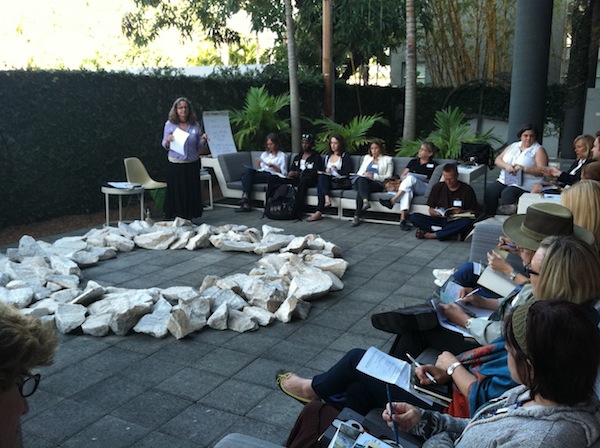
Around the campfire: Art & story in place
By Wendy Call, AIRE
We were all sitting around a campfire, or so it seemed. After three weeks in the Everglades National Park, I traveled to Miami’s Wynwood neighborhood to offer a writing workshop: “You Are Here: Creating a Sense of Place on the Page.” Thanks to the work of AIRIE and the University of Wynwood, two dozen of us gathered around the large circle of white rocks in the Rubell Collection’s expansive courtyard: poets, fiction writers, arts instigators, essayists, nature lovers and others.
Wynwood is my second-favorite neighborhood in Miami, eclipsed only to the Upper East Side, where I lived, on and off, for a couple of years. I so enjoy Wynwood’s bright jangle of old and new, art-in-warehouses and art-in-livingrooms, roaming food trucks and been-there- forever corner diners. Although Wynwood is many places to many people, it is most emphatically a place with a sense of itself. As is the Rubell Collection. Now a warehouse space showcasing the work of artists (like Secondino Hernández, Maria Nepomuceno, and Jason Rhoades) who make me think deeply, it was once a storage facility for illegal drugs impounded by the Drug Enforcement Agency. This transformation is a telling chapter in the story of Wynwood, of Miami, and of South Florida.
“Place is a story many times.” This wisdom was given to (or taken by?) anthropologist Franz Boas, from the Kwakiutl people of British Columbia’s Pacific coast. This idea deeply informs the work I was doing as Artist in Residence in Everglades National Park (AIRIE) for the month of January 2013.
My stay in the Everglades National Park was my fourth residency in a U.S. National Park. I’ve spent a total of seven months living and working in parks in the four corners of the continental United States. I hope to untangle some of the strange braid of environmentalism, patriotism, and imperialism that characterizes the history of our national parks. That untangling (and retangling) can only happen through story. And through story, I hope to understand more about place.
What does all this mean, exactly? I gave everyone who attended my Rubell Collection writing workshop a copy my “essay chapbook,” Tilled Paths Through Wilds of Thought, one result of my first national park artist residency. (You can read an excerpt at Guernica magazine.)
Around our courtyard campfire at the Rubell Collection, we talked about the words we associate with the Everglades: swamp and airboat (two things that the Everglades National Park doesn’t have), birds and sky, grass and water and greenness, and connection. Next, everyone wandered the museum until they found a work of art that called them to write about it. Writer Letisia Cruz’s time writing about a painting led her to think about the imperfection of true beauty. “That word imperfect is something I’m still struggling with,” she wrote to me later. “What I’m trying to say is not that beauty is imperfect, but that it’s perfect in its imperfection. I’m working on a poem about it and hopefully it will be beautiful (in its imperfection, hahaha).”
Visual artist Tom Virgin said the workshop prompted a realization: “[T]he last time I felt a total peace with the world was when I was in a place enjoying just that place, in time and space. I was not concerned with past or with what was to come. I was content.” He also saw a bit of irony in this contentment, because “it was a place that I will never be in again.”
Beauty and imperfection, peace and loss, story and place—these things that seem to be in contrast to one another are actually bound inextricably together, brought to light by our stories inspired by visual art, by our stories around the campfire, and by weaving stories into place.


Recent Content
-
Artsarticle ·
-
Artsarticle ·
-
Artsarticle ·
